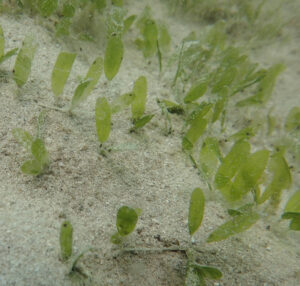Clover Grass, Halophila decipiens
 Clover Grass, Halophila decipiens. Underwater photograph taken in Bahia de La Paz, Baja California Sur, July 2019. Photo, identification, and related productive discussions courtesy of Abigail Cannon, La Jolla, California.
Clover Grass, Halophila decipiens. Underwater photograph taken in Bahia de La Paz, Baja California Sur, July 2019. Photo, identification, and related productive discussions courtesy of Abigail Cannon, La Jolla, California.
Phylogeny: Clover Grass, Halophila decipiens (Oltenfeld, 1902), is a member of the Hydrocharitaceae Family of Tape Grasses, which is also known as the Frog’s Bit Family of Flowering Plants. This particular species is often referred to as the Caribbean Seagrass, Hairy Spoon Seagrass, or Paddle Grass. Halophila is unique as it the only genus of seagrass that lacks basal sheaths on the leaf stems.
Morphology: Clover Grass resembles clover that is found in residential lawns. It has thin white rhizomes that run along just under the surface of muddy or sandy sea floors in shallow water with a root at each node to anchor the plant in place. Leaves, that grow in pairs, are attached to the nodes via a very short petiole. The leaves are oblong and paddle shaped, reaching sizes up to 2.5 cm (1.0 inch) by 0.6 cm (0.24 inches). The leaves have finely serrated margins, fine hairs on both sides affording a rough feel. The leaves are often coated with epiphytes. The species is monoecious, with male and female flowers found on the same spathe. The fruits are small, green, about 0.5 cm (0.2 inches) in diameter, and contain approximately 30 seeds. It is a euryhaline species that can tolerate low salinity and high sedimentation environments. Branching leads to intertwined plants and runners colonizing new substrate. Some believe this species to be transient.
Habitat and Distribution: Clover Grass is pantropical, found in the tropical regions of the Western Atlantic, Indian and Pacific Oceans at depths up to 60 m (200 feet). They can survive in lower light environments and are found in deeper waters than most known sea grasses. In Mexican waters, the Clover Grass is found off the Veracruz coast in the Gulf of Mexico. In the Pacific, they are exceedingly rare and have only been documented in one location, La Paz Bay, La Paz, Baja California Sur.
Predators: Clover Grass is consumed by Parrotfishes, Pinfish, Surgeonfish, Sea Turtles, and Sea Urchins.
Reproduction: Clover Grass seeds are know to survive the digestive tracts of Sea Turtles which enhances long range dispersal. They propagate through budding or via buried seed banks in new locations to reestablish their populations following cold water seasonal die-offs or physical disturbance. They are unable to effectively compete in areas where other species are established.
Ecosystem Interactions: In the Indian River Lagoon of southeast Florida, Clover Grass can be found mixed in with Halophila engelmannii and Halophila johnsonii to form mixed meadows that function as a source of food, a breeding ground, and a habitat for various flora and fauna.
Conservation Status: Clover Grass is currently considered to be of Least Concern with stable, widely distributed populations. The long-term viability of Clover Grass is of concern due to rising water temperatures causing a decrease in their populations. In shallow water environments, the temperature tends to fluctuate more. High temperatures cause deoxygenation in the water. As the water column becomes lower in oxygen it becomes harder for seagrasses to pass oxygen to their roots. Recreational activities such as jet skiing and boat damage that uproot seagrass beds in shallow coastal waters also has a negative impact on Clover Grass populations.
Request for Help. Our friend and strong contributor Abigail Cannon has asked us try to locate additional seagrass beds in the tropical waters of the Tropical Eastern Pacific which includes Mexican waters. We would greatly appreciate being advised of any sea grass beds that you might come across or are aware of in this area.